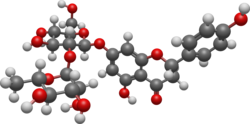
| |

| |
| Names | |
|---|---|
| IUPAC name
(2S)-4′,5-Dihydroxy-7-[α-L-rhamnopyranosyl-(1→2)-β-D-glucopyranosyloxy]flavan-4-one
| |
| Systematic IUPAC name
(2S)-7-{[(2S,3R,4S,5S,6R)-4,5-Dihydroxy-6-(hydroxymethyl)-3-{[(2S,3R,4R,5R,6S)-3,4,5-trihydroxy-6-methyloxan-2-yl]oxy}oxan-2-yl]oxy}-5-hydroxy-2-(4-hydroxyphenyl)-2,3-dihydro-4H-1-benzopyran-4-one | |
| Other names
Naringin
Naringoside 4′,5,7-Trihydroxyflavanone-7-rhamnoglucoside Naringenin 7-O-neohesperidoside | |
| Identifiers | |
3D model (JSmol)
|
|
| ChEBI | |
| ChEMBL | |
| ChemSpider | |
| ECHA InfoCard | 100.030.502 |
| KEGG | |
PubChem CID
|
|
| UNII | |
CompTox Dashboard (EPA)
|
|
| |
| |
| Properties | |
| C27H32O14 | |
| Molar mass | 580.54 g/mol |
| Melting point | 166 °C (331 °F; 439 K) |
Except where otherwise noted, data are given for materials in their standard state (at 25 °C [77 °F], 100 kPa).
| |
Naringin is a flavanone-7-O-glycoside between the flavanone naringenin and the disaccharide neohesperidose. The flavonoid naringin occurs naturally in citrus fruits, especially in grapefruit, where naringin is responsible for the fruit's bitter taste. In commercial grapefruit juice production, the enzyme naringinase can be used to remove the bitterness (debittering) created by naringin.[1] In humans naringin is metabolized to the aglycone naringenin (not bitter) by naringinase present in the gut.
- ^ Dicosimo R, McAuliffe J, Poulose AJ, Bohlmann G (2013). "Industrial use of immobilized enzymes". Chemical Society Reviews. 42 (15): 6437–6474. doi:10.1039/c3cs35506c. PMID 23436023.